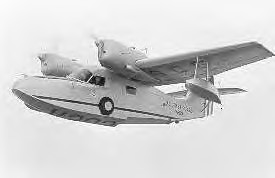The Grumman Widgeon, a two-engined amphibious aircraft which was originally to be called the Gosling I by the Royal Navy, was a smaller follow on to the Grumman G-22 JRF Goose amphibious aircraft, and was aimed at the executive and light Transport market. The prototype first flew in July 1940. The aircraft was soon adopted by the US military with the first production version being the J4F-1, used as in a utility and anti-submarine role. 167 aircraft were produced during the war, with 15 of these being supplied to the Royal Navy.
The Fleet Air Arm received 15 Grumman Widgeon G-44A J4F-2 Widgeon I delivered under Contract No Noa(S) 455 and numbered FP455-FP469. These started to be delivered to the RN for intended communications in the West Indies area. The first FP455 was delivered in October 1943 and most sent to Brunswick between March 1944 till April 1945. 738 squadron at Lewiston started to be equipped in July 1944. Operational squadrons equipped with the Widgeon included 857 squadron from May 1944 at Squantum (eg FP457), and 1835 squadron at Brunswick in January 1945.
Widgeons were based at the USNAS Air Training Centre, Pensacola from August till April 1945 for the Senior British Naval Officer. Most Widgeons were returned to US Navy charge between October and December 1945
One of the final Grumman Widgeons in RN service, was numbered JS996. It was based at Nassau in 1943, and later used at the Foreign Commission, Miami in February 1946 as the Admirals Barge. Post war, some of the U.S. aircraft were converted to Super Widgeon configuration and still fly commercially in USA, and New Zealand.

Manufacturer: Grumman
Powerplant: Two Pratt & Whitney 450-hp R-985-148 engines
Wing Span: 40 ft (12.2m)
Length: 31.1 ft (9.5m)
Height: 11.5 ft (3.5m)
Empty weight: 3,800lbs (1,724kg)
Max. weight: 5,200lbs (2,365kg)
Max. speed: 180mph (290km/h)
Max. climb: 1,550ft/min (472m/min)
Ceiling: 18,000ft (5,486m)
Range: 994 miles (1,600 km)
Armament: None
